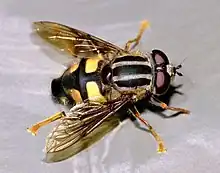| Helophilus seelandicus | |
|---|---|
 | |
| Scientific classification | |
| Kingdom: | |
| Phylum: | |
| Class: | |
| Order: | |
| Family: | |
| Subfamily: | |
| Tribe: | |
| Genus: | |
| Species: | H. seelandicus |
| Binomial name | |
| Helophilus seelandicus (Gmelin, 1790) | |
| Synonyms | |
| |
Helophilus seelandicus, commonly known as the three-lined hoverfly, is a hoverfly endemic to New Zealand. The common name corresponds to the three black lines behind the insect's head.
Taxonomy
This species was first described by Johann Friedrich Gmelin in 1790 and named Musca seelandica.[1] The taxonomy of this species was most recently discussed by F. Christian Thompson in 2008.[2]
Description
The adult fly is approximately 15 mm in length.[3]
Distribution
Life cycle
H. seelandicus maggots live in water with decaying vegetation, animals or dung.[5]
Interaction with humans
Despite being native to New Zealand, this species is commonly reported to the Ministry of Primary Industries Pest and Disease Hotline.[6]
References
Wikimedia Commons has media related to Helophilus seelandicus.
Wikispecies has information related to Helophilus seelandicus.
- ↑ Linné, Carl von; Gmelin, Johann Friedrich (1788–93). Caroli a Linné. Systema naturae per regna tria naturae : secundum classes, ordines, genera, species, cum characteribus, differentiis, synonymis, locis. Vol. 1 (Ed. 13., aucta, reformata. Cura Jo. Frid. Gmelin. ed.). Lipsiae: Lipsiae, impensis Georg. Emanuel. Beer. p. 2870.
- 1 2 F. CHRISTIAN THOMPSON (29 February 2008). "A conspectus of New Zealand flower flies (Diptera: Syrphidae) with the description of a new genus and species". Zootaxa. 1716 (1): 1. doi:10.11646/ZOOTAXA.1716.1.1. ISSN 1175-5334. Wikidata Q97484288.
- ↑ "Three-lined hoverfly". www.landcareresearch.co.nz. 2023. Retrieved 28 January 2023.
- ↑ "Helophilus seelandicus (Gmelin, 1790) - Biota of NZ". biotanz.landcareresearch.co.nz. Retrieved 2023-01-27.
- ↑ Crowe, Andrew (2002). Which New Zealand Insect?. Penguin Books. p. 63. ISBN 0141006366.
- ↑ Doddala, Prasad; Haw, James; France, Santha; Anderson, Diane; Marinov, Milen; Flynn, Alan (2018-07-30). "What's buzzing? A snapshot analysis of pest notifications". New Zealand Plant Protection. 71: 351. doi:10.30843/nzpp.2018.71.203. ISSN 1179-352X. S2CID 59348884.
External links
- Helophilus seelandicus discussed in RNZ Critter of the Week, 27 January 2023
This article is issued from Wikipedia. The text is licensed under Creative Commons - Attribution - Sharealike. Additional terms may apply for the media files.